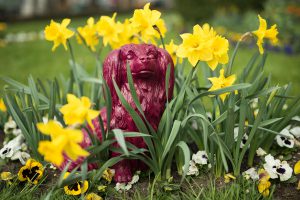The „Folichon“ installation by Professor Ottmar Hörl
Innovation and the idea of the democratisation of sculpture are essential elements of Professor Ottmar Hörl’s recipe for global success. The internationally renowned conceptual artist has taken the idea of sculpture further than almost anyone else. His vision is to familiarise everyone with art. This is why his sculptural projects in public space are always major events. Events that provide powerful pictures, bring about a sense of identity, and spark communication. With his installations centring on Richard Wagner and based on his maxim of „sculpture as an organisational principle“, Hörl has given rise to much discussion and furore in Bayreuth several times before.
The Wilhelmina Society is looking forward to Ottmar Hörl’s new project, which, on the occasion of this year’s Landesgartenschau garden festival, is a compassionate way of putting Margravine Wilhelmina in the public eye.

In her lifetime, Wilhelmina enjoyed having herself pictured along with her lap dog. Folichon, which means ‚amusing‘, ‚charming‘ or ‚cute‘, is a papillon dog (also called continental toy spaniel or butterfly dog), her favourite dog and the animal she used as a symbol of herself. „Dearest she-dog. I love you and adore you“, Wilhelmina, in the guise of Folichon, wrote to Biche, her brother Frederick II’s dog, in 1748.
This famous exchange of letters went down in the history of literature as the „Dog Letters“. Folichon also has a central position in the painting decorating the ceiling in Wilhelmina’s state apartment at the Hermitage. The scene depicts Chilonis, who followed her husband Cleombrotus into exile, and was read as a hint at Wilhelmina’s own situation (detail, illus. 2). Particularly the portrait of Wilhelmina in pilgrim’s garb, painted by court painter Antoine Pesne around 1750 (illus. 1), inspired later generations of artists, such as the Räntz brothers. In 1768, they created the marble sculpture (illus. 3) commissioned by Frederick II for the Temple of Friendship at Sanssouci Park.

The idea of art as a stimulus that may be rephrased in contemporary terms, and transformed into the 21st century, is central to Ottmar Hörl’s oeuvre. He has adopted the Folichon motif so that Wilhelmina’s favourite dog, turned into a modern serial sculpture, will be taking Bayreuth by storm. Certainly, he is also set to steal the hearts of all visitors.
Bernd Saupe, Chairman of the Margravine Wilhelmina Society
Flyer_Folichon_E to download as PDF.


Neueste Kommentare